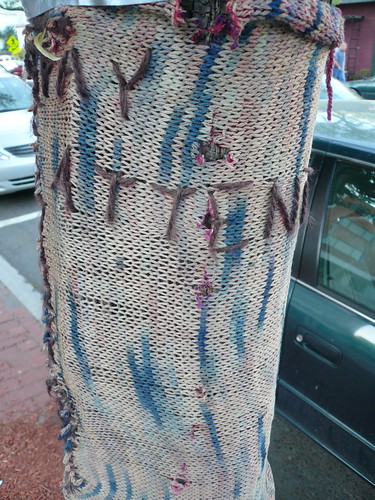Or How Three Groups Realized Common Ground
Things started out with what must be the 8th round of personal introductions. But nobody minded as there were new faces, and it provided yet another opportunity for the interns to learn one another’s names.
At least that’s what I was used it for.
After a brief note on tagging relevant material for delicious, and a reminder that by next week the intern community must decide upon the summer’s group trip, Carolina Rossini of Copyright for Librarians spoke up. She explained that her project had recently realized some common ground with two other groups, the Digital Natives project, and Adam Holland’s work with Lewis Hyde. As a result, Rossini explained, the three groups now were working in tandem and had great collective energy that allowed for rich collaboration and support. It was, as Rossini, explained as though the three groups had become a sort of triple helix, each representing a different community of education. Copyright for Librarians, of course, represented librarians, Adam Holland’s worked was geared towards teachers, and the Digital Natives project was interested in students.
Rossini then turned it over to Adam Holland, who further elaborated on his own research and the common ground it shares with other work at the Berkman Center. Working with Lewis Hyde, Holland hopes to create a guide line for fair use, one that improves upon existing guide lines that are often produced by content holders, who wish to restrict fair use. Holland feels that not enough people take advantage of the fair use provision in copyright law, largely because of corporate intimidation and conservative institutional policies that wish to avoid conflict by not even chancing fair use appropriation. The challenge, of course, is that fair use is a loose, non-explicit option for copyright that is hard to quantify and explain to the average citizens
Holland hopes that because of a recent 8-page publication, Best Practices in Fair Use, people will take more confidence in employing fair use. Moreover, it may follow that the community will come to see this terms, “best practices,” as standards and will therefore naturalize this standards toward codified law.
that the community will come to see this terms, “best practices,” as standards and will therefore naturalize this standards toward common cultural paradigms.
Nikki Leon and Jacob Kramer-Duffield, both with the Digital Natives program, then spoke up for the third strand of the triple helix. Both felt that the group’s current work responded to a recent survey, which demonstrated that most teachers do not understand what is the domain of copyright and what is fair use, particularly fair use for education. The group has taken this as an incentive to inform, hoping to follow-up on this statistic and seeking to educate educators such that they will feel confident in fair use and producing creative commons content for other educators. Kramer-Duffield, explained that the current manner of implementing this mission should take the form of various web videos, and explanatory media, packaging certain lessons.
John Randall, also with the Digital Natives project, followed that this was only the first of three phases for implementing/responding to the idea of digital natives. The summer interns, however, were quick to admit that they were likely to only see the first phase, and simply create a frame work for the later work. Randall also discussed Scratch, an MIT web-app and interface that allows for cheap, easy, animation. As an interface, Scratch is “a cross between Flash and visual basic” according to Randall, but has proved to be an interesting space for kids to engage with copyright and plagiarism issues, when users began “borrowing” material, or making subtle tweaks to existing work and calling it their own.
Carolina Rossini cautioned that while this projects may address local issues, over target American education, they will have repercussions all over the world and may serve as a model for the international community that are being to consider these same issues for their country and education systems.
Holland rejoined that it is important that his work represent “an aggregate wisdom,” a knowledge that many people have contributed to, discussed, and come to a consensus, so that it may be helpful for society at large. Otherwise, it represents a single perspective, that however strong, lacks support and therefore is not as informed as a consensus-based guideline might prove.
“The basic goal is to shift people’s perspective from where copyright is the bogeyman,” said Kramer-Duffield, “to a place where people might think of it as fluid, as something to engage with.”
— Zachary McCune

